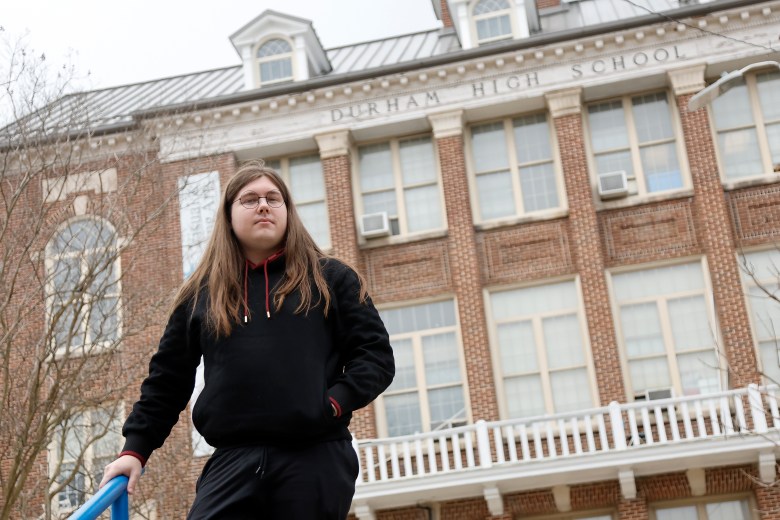Tag: gun
-

Schools are surveilling kids to prevent gun violence or suicide. The lack of privacy comes at a cost
The Education Reporting Collaborative, a coalition of eight newsrooms, is investigating the unintended consequences of AI-powered surveillance at schools. Members of the Collaborative are AL.com, The Associated Press, The Christian Science Monitor, The Dallas Morning News, The Hechinger Report, Idaho Education News, The Post and Courier in South Carolina, and The Seattle Times.
One student asked a search engine, “Why does my boyfriend hit me?” Another threatened suicide in an email to an unrequited love. A gay teen opened up in an online diary about struggles with homophobic parents, writing they just wanted to be themselves.
In each case and thousands of others, surveillance software powered by artificial intelligence immediately alerted Vancouver Public Schools staff in Washington state.
Vancouver and many other districts around the country have turned to technology to monitor school-issued devices 24/7 for any signs of danger as they grapple with a student mental health crisis and the threat of shootings.
The goal is to keep children safe, but these tools raise serious questions about privacy and security – as proven when Seattle Times and Associated Press reporters inadvertently received access to almost 3,500 sensitive, unredacted student documents through a records request about the district’s surveillance technology.
The released documents show students use these laptops for more than just schoolwork; they are coping with angst in their personal lives.
Tim Reiland, 42, center, the parent of daughter Zoe Reiland, 17, right, and Anakin Reiland, 15, photographed in Clinton, Miss., Monday, March 10, 2025, said he had no idea their previous schools, in Oklahoma, were using surveillance technology to monitor the students. (AP Photo/Rogelio V. Solis) Students wrote about depression, heartbreak, suicide, addiction, bullying and eating disorders. There are poems, college essays and excerpts from role-play sessions with AI chatbots.
Vancouver school staff and anyone else with links to the files could read everything. Firewalls or passwords didn’t protect the documents, and student names were not redacted, which cybersecurity experts warned was a massive security risk.
The monitoring tools often helped counselors reach out to students who might have otherwise struggled in silence. But the Vancouver case is a stark reminder of surveillance technology’s unintended consequences in American schools.
In some cases, the technology has outed LGBTQ+ children and eroded trust between students and school staff, while failing to keep schools completely safe.
Gaggle, the company that developed the software that tracks Vancouver schools students’ online activity, believes not monitoring children is like letting them loose on “a digital playground without fences or recess monitors,” CEO and founder Jeff Patterson said.
Related: A lot goes on in classrooms from kindergarten to high school. Keep up with our free weekly newsletter on K-12 education.
Roughly 1,500 school districts nationwide use Gaggle’s software to track the online activity of approximately 6 million students. It’s one of many companies, like GoGuardian and Securly, that promise to keep kids safe through AI-assisted web surveillance.
The technology has been in high demand since the pandemic, when nearly every child received a school-issued tablet or laptop. According to a U.S. Senate investigation, over 7,000 schools or districts used GoGuardian’s surveillance products in 2021.
Vancouver schools apologized for releasing the documents. Still, the district emphasizes Gaggle is necessary to protect students’ well-being.
“I don’t think we could ever put a price on protecting students,” said Andy Meyer, principal of Vancouver’s Skyview High School. “Anytime we learn of something like that and we can intervene, we feel that is very positive.”
Dacia Foster, a parent in the district, commended the efforts to keep students safe but worries about privacy violations.
“That’s not good at all,” Foster said after learning the district inadvertently released the records. “But what are my options? What do I do? Pull my kid out of school?”
Foster says she’d be upset if her daughter’s private information was compromised.
“At the same time,” she said, “I would like to avoid a school shooting or suicide.”
Related: Ed tech companies promise results, but their claims are often based on shoddy research
Gaggle uses a machine learning algorithm to scan what students search or write online via a school-issued laptop or tablet 24 hours a day, or whenever they log into their school account on a personal device. The latest contract Vancouver signed, in summer 2024, shows a price of $328,036 for three school years – approximately the cost of employing one extra counselor.
The algorithm detects potential indicators of problems like bullying, self-harm, suicide or school violence and then sends a screenshot to human reviewers. If Gaggle employees confirm the issue might be serious, the company alerts the school. In cases of imminent danger, Gaggle calls school officials directly. In rare instances where no one answers, Gaggle may contact law enforcement for a welfare check.
A Vancouver school counselor who requested anonymity out of fear of retaliation said they receive three or four student Gaggle alerts per month. In about half the cases, the district contacts parents immediately.
“A lot of times, families don’t know. We open that door for that help,” the counselor said. Gaggle is “good for catching suicide and self-harm, but students find a workaround once they know they are getting flagged.”
Related: Have you had experience with school surveillance tech? Tell us about it
Seattle Times and AP reporters saw what kind of writing set off Gaggle’s alerts after requesting information about the type of content flagged. Gaggle saved screenshots of activity that set off each alert, and school officials accidentally provided links to them, not realizing they weren’t protected by a password.
After learning about the records inadvertently released to reporters, Gaggle updated its system. Now, after 72 hours, only those logged into a Gaggle account can view the screenshots. Gaggle said this feature was already in the works but had not yet been rolled out to every customer.
The company says the links must be accessible without a login during those 72 hours so emergency contacts—who often receive these alerts late at night on their phones—can respond quickly.
In Vancouver, the monitoring technology flagged more than 1,000 documents for suicide and nearly 800 for threats of violence. While many alerts were serious, many others turned out to be false alarms, like a student essay about the importance of consent or a goofy chat between friends.
Foster’s daughter Bryn, a Vancouver School of Arts and Academics sophomore, was one such false alarm. She was called into the principal’s office after writing a short story featuring a scene with mildly violent imagery.
“I’m glad they’re being safe about it, but I also think it can be a bit much,” Bryn said.
School officials maintain alerts are warranted even in less severe cases or false alarms, ensuring potential issues are addressed promptly.
“It allows me the opportunity to meet with a student I maybe haven’t met before and build that relationship,” said Chele Pierce, a Skyview High School counselor.
Related: Students work harder when they think they are being watched
Between October 2023 and October 2024, nearly 2,200 students, about 10% of the district’s enrollment, were the subject of a Gaggle alert. At the Vancouver School of Arts and Academics, where Bryn is a student, about 1 in 4 students had communications that triggered a Gaggle alert.
While schools continue to use surveillance technology, its long-term effects on student safety are unclear. There’s no independent research showing it measurably lowers student suicide rates or reduces violence.
A 2023 RAND study found only “scant evidence” of either benefits or risks from AI surveillance, concluding: “No research to date has comprehensively examined how these programs affect youth suicide prevention.”
“If you don’t have the right number of mental health counselors, issuing more alerts is not actually going to improve suicide prevention,” said report co-author Benjamin Boudreaux, an AI ethics researcher.
In the screenshots released by Vancouver schools, at least six students were potentially outed to school officials after writing about being gay, trans or struggling with gender dysphoria.
LGBTQ+ students are more likely than their peers to suffer from depression and suicidal thoughts, and turn to the internet for support.
“We know that gay youth, especially those in more isolated environments, absolutely use the internet as a life preserver,” said Katy Pearce, a University of Washington professor who researches technology in authoritarian states.
In one screenshot, a Vancouver high schooler wrote in a Google survey form they’d been subject to trans slurs and racist bullying. Who created this survey is unclear, but the person behind it had falsely promised confidentiality: “I am not a mandated reporter, please tell me the whole truth.”
When North Carolina’s Durham Public Schools piloted Gaggle in 2021, surveys showed most staff members found it helpful.
But community members raised concerns. An LGBTQ+ advocate reported to the Board of Education that a Gaggle alert about self-harm had led to a student being outed to their family, who were not supportive.

Glenn Thompson, a Durham School of the Arts graduate, poses in front of the school in Durham, N.C., Monday, March 10, 2025. (AP Photo/Karl DeBlaker) Glenn Thompson, a Durham School of the Arts graduate, spoke up at a board meeting during his senior year. One of his teachers promised a student confidentiality for an assignment related to mental health. A classmate was then “blindsided” when Gaggle alerted school officials about something private they’d disclosed. Thompson said no one in the class, including the teacher, knew the school was piloting Gaggle.
“You can’t just (surveil) people and not tell them. That’s a horrible breach of security and trust,” said Thompson, now a college student, in an interview.
After hearing about these experiences, the Durham Board of Education voted to stop using Gaggle in 2023. The district ultimately decided it was not worth the risk of outing students or eroding relationships with adults.
Related: School ed tech money mostly gets wasted. One state has a solution
The debate over privacy and security is complicated, and parents are often unaware it’s even an issue. Pearce, the University of Washington professor, doesn’t remember reading about Securly, the surveillance software Seattle Public Schools uses, when she signed the district’s responsible use form before her son received a school laptop.
Even when families learn about school surveillance, they may be unable to opt out. Owasso Public Schools in Oklahoma has used Gaggle since 2016 to monitor students outside of class.
For years, Tim Reiland, the parent of two teenagers, had no idea the district was using Gaggle. He found out only after asking if his daughter could bring her personal laptop to school instead of being forced to use a district one because of privacy concerns.
The district refused Reiland’s request.
When his daughter, Zoe, found out about Gaggle, she says she felt so “freaked out” that she stopped Googling anything personal on her Chromebook, even questions about her menstrual period. She didn’t want to get called into the office for “searching up lady parts.”
“I was too scared to be curious,” she said.
School officials say they don’t track metrics measuring the technology’s efficacy but believe it has saved lives.
Yet technology alone doesn’t create a safe space for all students. In 2024, a nonbinary teenager at Owasso High School named Nex Benedict died by suicide after relentless bullying from classmates. A subsequent U.S. Department of Education Office for Civil Rights investigation found the district responded with “deliberate indifference” to some families’ reports of sexual harassment, mainly in the form of homophobic bullying.
During the 2023-24 school year, the Owasso schools received close to 1,000 Gaggle alerts, including 168 alerts for harassment and 281 for suicide.
When asked why bullying remained a problem despite surveillance, Russell Thornton, the district’s executive director of technology responded: “This is one tool used by administrators. Obviously, one tool is not going to solve the world’s problems and bullying.”
Related: Schools prove soft targets for hackers
Despite the risks, surveillance technology can help teachers intervene before a tragedy.
A middle school student in the Seattle-area Highline School District who was potentially being trafficked used Gaggle to communicate with campus staff, said former superintendent Susan Enfield.
“They knew that the staff member was reading what they were writing,” Enfield said. “It was, in essence, that student’s way of asking for help.”
Still, developmental psychology research shows it is vital for teens to have private spaces online to explore their thoughts and seek support.
“The idea that kids are constantly under surveillance by adults — I think that would make it hard to develop a private life, a space to make mistakes, a space to go through hard feelings without adults jumping in,” said Boudreaux, the AI ethics researcher.
Gaggle’s Patterson says school-issued devices are not the appropriate place for unlimited self-exploration. If that exploration takes a dark turn, such as making a threat, “the school’s going to be held liable,” he said. “If you’re looking for that open free expression, it really can’t happen on the school system’s computers.”
Claire Bryan is an education reporter for The Seattle Times. Sharon Lurye is an education data reporter for The Associated Press.
Contact Hechinger managing editor Caroline Preston at 212-870-8965, on Signal at CarolineP.83 or via email at [email protected].
This story about AI-powered surveillance at schools was produced by the Education Reporting Collaborative, a coalition of eight newsrooms that includes AL.com, The Associated Press, The Christian Science Monitor, The Dallas Morning News, The Hechinger Report, Idaho Education News, The Post and Courier in South Carolina, and The Seattle Times.
-

Cosmetologists can’t shoot a gun? FIRE ‘blasts’ tech college for punishing student over target practice video
Language can be complicated. According to Merriam-Webster, the verb “blast” has as many as 15 different meanings — “to play loudly,” “to hit a golf ball out of a sand trap with explosive force,” “to injure by or as if by the action of wind.”
Recently, the word has added another definition to the list. Namely, “to attack vigorously” with criticism, as in, “to blast someone online” or “to put someone on blast.” This usage has become a common expression.
That’s what Leigha Lemoine, a student at Horry-Georgetown Technical College, meant when she posted in a private Snapchat group that a non-student who had insulted her needed to get “blasted.”
But HGTC’s administration didn’t see it that way. When some students claimed they felt uncomfortable with Lemoine’s post, the college summoned her to a meeting. Lemoine explained that the post was not a threat of physical harm, but rather a simple expression of her belief that the person who had insulted her should be criticized for doing so. The school’s administrators agreed and concluded there was nothing threatening in her words.
But two days later, things took a turn. Administrators discovered a video on social media of Lemoine firing a handgun at a target. The video was recorded off campus a year prior to the discovery, and had no connection to the “blasted” comment, but because she had not disclosed the video’s existence (why would she be required to?), the college decided to suspend her until the 2025 fall semester. Adding insult to injury, HGTC indicated she Lemoine would be on disciplinary probation when she returned.
Screenshots of Leigha Lemoine’s video on social media. HGTC administrators claim Lemoine’s post caused “a significant amount of apprehension related to the presence and use of guns.”
“In today’s climate, your failure to disclose the existence of the video, in conjunction with group [sic] text message on Snapchat where you used the term ‘blasted,’ causes concern about your ability to remain in the current Cosmetology cohort,” the college added.
Never mind the context of the gun video, which had nothing to do with campus or the person she said needed to get “blasted.” HGTC was determined to jeopardize Lemoine’s future over one Snapchat message and an unrelated video.
Colleges and universities would do well to take Lemoine’s case as a reminder to safeguard the expressive freedoms associated with humor and hyperbolic statements. Because make no mistake, FIRE will continue to blast the ones that don’t.
FIRE wrote to HGTC on Lemoine’s behalf on Oct. 7, 2024, urging the college to reverse its disciplinary action against Lemoine. We pointed out the absurdity of taking Lemoine’s “blasted” comment as an unprotected “true threat” and urged the college to rescind her suspension. Lemoine showed no serious intent to commit unlawful violence with her comment urging others to criticize an individual, and tying the gun video to the comment was both nonsensical and deeply unjust.
But HGTC attempted to blow FIRE off and plowed forward with its discipline. So we brought in the big guns — FIRE Legal Network member David Ashley at Le Clercq Law Firm took on the case, filing an emergency motion for a temporary restraining order. On Dec. 17, a South Carolina federal district court ordered HGTC to allow her to return to classes immediately while the case works its way through the courts.
Jokes and hyperbole are protected speech
Colleges and universities must take genuine threats of violence on campus seriously. That sometimes requires investigations and quick institutional action to ensure campus safety. But HGTC’s treatment of Lemoine is the latest in a long line of colleges misusing the “true threats” standard to punish clearly protected speech — remarks or commentary that are meant as jokes, hyperbole, or otherwise unreasonable to treat as though they are sincere.
Take over-excited rhetoric about sports. In 2022, Meredith Miller, a student at the University of Utah, posted on social media that she would detonate the nuclear reactor on campus (a low-power educational model with a microwave-sized core that one professor said “can’t possibly melt down or pose any risk”) if the football team lost its game. Campus police arrested her, and the Salt Lake County District Attorney’s Office charged her with making a terroristic threat.
The office eventually dropped the charge, but the university tried doubling down by suspending her for two years. It was only after intervention from FIRE and an outside attorney that the university relented. But that it took such significant outside pressure — especially over a harmless joke that was entirely in line with the kind of hyperbolic rhetoric one expects in sports commentary — reveals how dramatically the university overreacted.
Political rhetoric is often targeted as well. In 2020, Babson College professor Asheen Phansey found himself in hot water after posting a satirical remark on Facebook. After President Trump tweeted a threat that he might bomb 52 Iranian cultural sites, Phansey jokingly suggested that Iran’s leadership should publicly identify a list of American cultural heritage sites it wanted to bomb, including the “Mall of America” and the “Kardashian residence.” Despite FIRE’s intervention, Babson College’s leadership suspended Phansey and then fired him less than a day later.
Or consider an incident in which Louisiana State University fired a graduate instructor who left a heated, profanity-laced voicemail for a state senator in which he criticized the senator’s voting record on trans rights. The senator reported the voicemail to the police, who investigated and ultimately identified the instructor. The police closed the case after concluding that the instructor had not broken the law. You’re supposed to be allowed to be rude to elected officials. LSU nevertheless fired him.
More examples of universities misusing the true threats standard run the political gamut: A Fordham student was suspended for a post commemorating the anniversary of the Tianneman Square massacre; a professor posted on social media in support of a police officer who attacked a journalist and was placed on leave; an adjunct instructor wished for President Trump’s assassination and had his hiring revoked; another professor posted on Facebook supporting Antifa, was placed on leave, and then sued his college. Too often, the university discipline is made more egregious by the fact that administrators continue to use the idea of “threatening” speech to punish clearly protected expression even after local police departments conclude that the statements in question were not actually threatening.
What is a true threat?
Under the First Amendment, a true threat is defined as a statement where “the speaker means to communicate a serious expression of an intent to commit an act of unlawful violence to a particular individual or group of individuals.”
That eliminates the vast majority of threatening speech you hear each day, and for good reason. One of the foundational cases for the true threat standard is Watts v. U.S., in which the Supreme Court ruled that a man’s remark about his potential draft into the military — “If they ever make me carry a rifle, the first man I want to get in my sights is LBJ” — constituted political hyperbole, not a true threat. The Court held that such statements are protected by the First Amendment. And rightfully so: Political speech is where the protection of the First Amendment is “at its zenith.” An overbroad definition of threatening statements would lead to the punishment of political advocacy. Look no further than controversies in the last year and a half over calls for genocide to see how wide swathes of speech would become punishable if the standard for true threats was lower.
Colleges and universities would do well to take Lemoine’s case as a reminder to safeguard the expressive freedoms associated with humor and hyperbolic statements. Because make no mistake, FIRE will continue to blast the ones that don’t.

